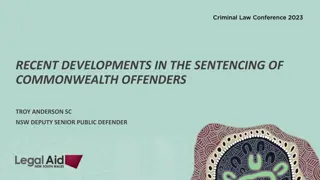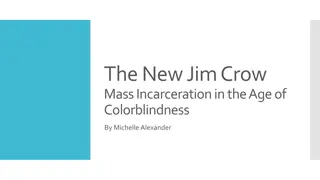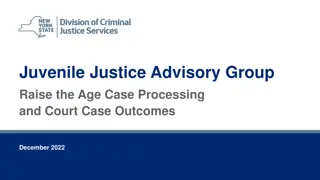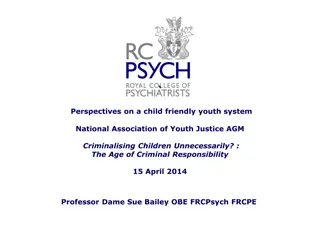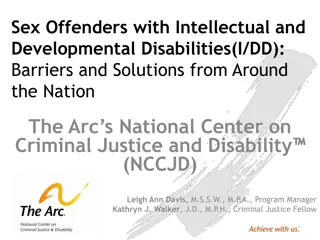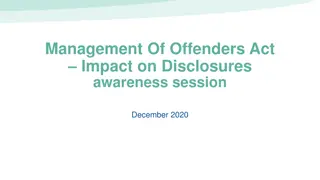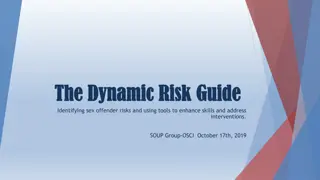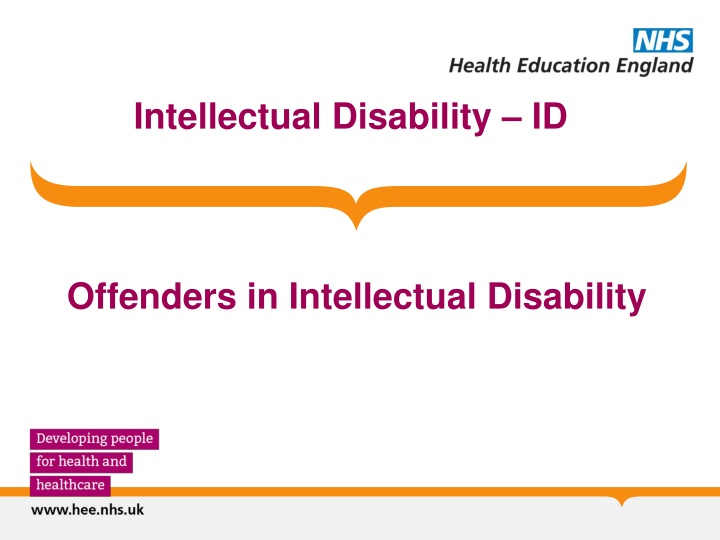
Intellectual Disability Offenders and Crime
Explore the relationship between intellectual disability and crime, including differences in offending behaviors, treatment options, and outcomes. Learn about the impact of intelligence on criminal behavior and the characteristics of intellectual disability offenders.
Download Presentation

Please find below an Image/Link to download the presentation.
The content on the website is provided AS IS for your information and personal use only. It may not be sold, licensed, or shared on other websites without obtaining consent from the author. If you encounter any issues during the download, it is possible that the publisher has removed the file from their server.
You are allowed to download the files provided on this website for personal or commercial use, subject to the condition that they are used lawfully. All files are the property of their respective owners.
The content on the website is provided AS IS for your information and personal use only. It may not be sold, licensed, or shared on other websites without obtaining consent from the author.
E N D
Presentation Transcript
Intellectual Disability ID Offenders in Intellectual Disability
Offenders in Intellectual Disability Aims and Objectives (from handbook) Awareness of differences in offending behaviours in ID population Outcome following Offence Treatment options for offenders with ID
Offenders in Intellectual Disability To achieve this Case Presentation Journal Club 555 Presentation Expert-Led Session MCQs Please sign the register and complete the feedback
Offenders in Intellectual Disability Expert Led Session Forensic Psychiatry of Intellectual Disability Dr M A Razzaque Dr Burke Dr Gupta
Relationship of Mental retardation to crime IQ for sex offenders was significantly lower than that of other offenders (East, 1942) Suggested intelligence was a factor in determining types of crime (Foxn USA, 1946) High intelligence was related to forgery Low intelligence was related to sex offending and vagrancy
Relationship of Mental Retardation to crime Delinquency was principally a problem of mild mental retardation (Ferguson, 1952) Conviction rate : Early age of onset Increased frequency
Relationship of Mental Retardation to crime Walker and McComb (1973) found one third of males identified as mentally retarded were sex offenders victims were children Mentally impaired female sex offenders tended to be involved in soliciting, prostitution or incest they became victims as much as offenders Association between arson and mental retardation was confined to fire-setting behaviour
General Characteristics As in the general population, intellectual disability offenders are essentially a male phenomena Typical the male offender with intellectual disability is functioning in mild borderline intellectual range Is in the early 20 s From poor urban environment Has suffered an unsettled and deprived upbringing Is likely to have a history of behavioural disorders
General Characteristics continued History of previous convictions Residential placement Shown evidence of psychiatric disturbance and personality disorder They share many features in common with non-LD offenders Robertson, 1981, has pointed out that they differed significantly from mentally ill offenders whose criminal behaviour is in the main, secondary to psychiatric disorder
General Characteristics continued Mentally ill offenders were found to be: -Older at first conviction -Had more admissions to psychiatric hospitals - Showed a high frequency of violence - Tended to be detained for shorter periods - Committed fewer serious offences during the follow-up period
Patterns of Offending Behaviour The pattern for offending in patients with intellectual disability shows considerable differences from that of the general population
Patterns of offending behaviour Whilst property offences are the commonest offences in both groups sex offences and arson are over represented in patients with intellectual disability Crimes involving serious personal violence, including murder, are under represented Recidivism, or relapse is common in offenders who have intellectual disability
Aetiology Offending in patients with intellectual disability is nearly always the consequence of impaired self- control, under socialisation and faulty social learning
Cognitive functioning and personality Impaired cognitive functioning means the individual is intellectually less capable of reasoning out the consequences of his or her actions less well equipped to resist temptation more easily led into offending by others
Cognitive functioning and personality -Impulsivity and gullibility are the hallmarks of offending in people with intellectual disability - Joint offences often with intelligent superiors are common - Patients with severe Mental Retardation are often unable to comprehend that their behaviour is legally wrong
Brain damage and cerebral abnormality The association between criminal behaviour with cerebral abnormality and epilepsy has long been established High incidence of EEG abnormalities found in unstable and violent offenders The number of confirmed epileptics in the prison population is significantly greater than in the general population
Brain damage and cerebral abnormality Studies have demonstrated the association between prematurity and birth complications and subsequent anti-social behaviour Anti-social behaviour , personality change following head injury Damage to the frontal lobe and limbic system resulting in social disinhibited behaviour and sometimes offending in a previously law-abiding person Reduced frustration, tolerance and increased irritability with excessive and often explosive response to trivial provocation
Physical and mental health Higher than normal prevalence of minor auditory and visual defects have been found in studies of people with intellectual disability Although minor in themselves, they are thought to contribute to the alienation of individuals from society Impede the process of socialisation and social learning
Psychosocial factors Low social economic class High incidences of neighbourhood crime Broken homes Chronic unemployment Poverty Urban settings Faulty child rearing practice Family history of criminality and associated with delinquency and criminal behaviour in general and is also seen in intellectual disability offenders
Psychodynamic factors Psychological mechanism frequently plays an important role in their offending behaviour Delinquent behaviour is often motivated by status seeking The learning disabled youth, achieving acceptance with his peer group membership of the gang, and sometimes high status which he could never otherwise hope for by participating in offending and daring escapades
Psychodynamic factors Difficulty in establishing sexual relationships with the opposite sex, coupled with poor impulse control and courtship techniques Communication difficulties may lead to the misinterpretation of harmless intentions with criminal acts as a possible consequences Loss of caring relatives or moving to a less structured setting can result in offending
Presentations Theft, robbery, burglary and acts of vandalism are the commonest form There is frequently an opportunist, unplanned component to the offences with lack of sensible precautions Thoughtless and sometimes an excitement factor The chances of getting caught are high because of the general lack of awareness and ineptitude once it comes to escaping or concealing tracks
Presentations The majority of offences are committed jointly, usually with more intelligent peers Gaining acceptance within the group may be the motivating factor Solitary delinquent acts are less common and usually result from the inability to control an overwhelming desire or an over reaction to frustrations in a temperamentally predisposed individual
Sex offenders majority of incidents are of a minor nature, mainly incidents of exposure and minor indecent assault due to the consequences of normal sex drive coupled with lack of opportunities for normal sexual outlets compounded by poor impulse control, lack of social skills and protective and restrictive families
Sex offenders Indecent exposure is typically carried out impulsively without precautions to escape detection frequently from window or door of the family home or in the street or local parks. The incidents of indecent exposure are equally impulsive and are rarely harmful to the victim Misinterpretation of the friendliness shown by female staff, neighbours or female friends sometimes result in inappropriate sexual advances
Sex offenders Persistent and more serious offenders, on the other hand, tend to come from highly disturbed family backgrounds, show evidence of personality disorder and commit ranges of other offence Are indiscriminate in their choice of victim and frequently use violence A high percentage of the victims are children and usually below the age of 14 years
Arson Most studies show it to be particularly associated with low intelligence and mental retardation Mainly 16-25 age group High incidents of attempted suicide, self mutilation, psychotic overlay and property offences Much lower incidents of aggression towards others and sex offences, compared to the control group
Arson Scott, 1978, separated fire setting into motivated and motiveless groups In the motivated group there was a clear motive of profit, such as revenge, concealments of other crimes or sometimes political or racial reasons The vast majority of the intellectual disability arsonists fall in to the motiveless group presence of mental illness
Guiding principles Mental Health Act code of practice Mental Capacity Act 2005 Human Rights Act: Article 5 (liberty and safety) Good Lives Model (Professor Tony Ward, 2004):Primary goods Bradley Report 2009 and revised 2014 Faculty Report FR/ID/04 February 2014 5 year forward view Transforming Care Valuing People (2001)
Forensic care pathways People with intellectual disability should have equitable legal and civil rights to other people. Those who are at risk of offending should also have a right to be held accountable for intentional actions, to have fair boundaries set and to have the full range of sentencing options available to them, if convicted. In view of their vulnerability and limited understanding, they may have difficulty in exercising their rights within the criminal justice system. Consequently, they may need support when they enter the criminal justice system.
Assessment of Forensic risk Collecting information relevant to the likelihood of harm, threat or danger. Analysis of factors that may cause harm with the aim of making decisions about the most appropriate action to take. Judgement of: How likely a person is to cause harm to others? Who those at risk might be? What situations might increase or decrease that risk? What is the severity of the risk? Formulation to inform intervention
Risk assessments Structured Professional Judgement assessments: Structured Assessment of Protective Factors for violence risk (SAPROF) HCR-20 with risk and protective factors interview Risk of Sexual Violence Protocol (RSVP) Dynamic factors assessments: Assessment of Risk and Manageability of Individuals with Developmental and Intellectual Limitations who Offend(Armadilo- S)
Supportive structures Delivery of care Informed care Agreed package of care Resource allocation and funding Legal framework to deliver?: Licence conditions Court orders MCA:DoLS MHA: CTO Care co-ordination through CPA MDT support MAPPA and MARAC processes Risk clinics Liaison and Diversion services Probation services Victim Liaison Officers
Cases : Group exercice 4 clinical cases 4 groups Scribe Spokesperson
Offenders in Intellectual Disability MCQs 1. Offenders with ID compared to other offenders: A. Start offending at a later age B. Frequently are convicted of single offences C. Arson offences are over represented D. More in severe and profound disability E. Less likely to be convicted
Offenders in Intellectual Disability MCQs 2. Mentally ill offenders with ID were found to be: A. Younger at first conviction B. Had less admissions to psychiatric hospitals C. Showed a high frequency of violence D. Tended to be females E. Committed more serious offences during the follow-up period
Offenders in Intellectual Disability MCQs 3. In patients with ID referred for evaluation for a report, the percentage felt not competent to stand trial is (approximately): A. Up to 10% B. 11 20% C. 21 30% D. 31 40% E. 41 50%
Offenders in Intellectual Disability MCQs 4. In offenders with ID the following is the most commonly used form of psychosocial input/therapy: A. Psychodynamic Psychotherapy B. Gestalt Therapy C. Cognitive Behavioural Therapy D. Response and Stimulus Prevention E. Dialectical Behavioural Therapy
Offenders in Intellectual Disability MCQs 5. Regarding the PCL-R: A. Low scores are related to recidivism B. Relates to Cluster A personality disorders C. Those in medium security have higher scores than those in high security D. Scoring patterns in ID populations are significantly different compared to the general population E. High scores relate to aggression
Offenders in Intellectual Disability MCQs- Answers 1. Offenders with ID compared to other offenders: A. Start offending at a later age B. Frequently are convicted of single offences C. Arson offences are over represented D. More in severe and profound disability E. Less likely to be convicted
Offenders in Intellectual Disability MCQs Answers 2. Mentally ill offenders with ID were found to be: A. Younger at first conviction B. Had less admissions to psychiatric hospitals C. Showed a high frequency of violence D. Tended to be females E. Committed more serious offences during the follow-up period
Offenders in Intellectual Disability MCQs 3. In patients with ID referred for evaluation for a report, the percentage felt not competent to stand trial is (approximately): A. Up to 10% B. 11 20% C. 21 30% D. 31 40% E. 41 50%
Offenders in Intellectual Disability MCQs 4. In offenders with ID the following is the most commonly used form of psychosocial input/therapy: A. Psychodynamic Psychotherapy B. Gestalt Therapy C. Cognitive Behavioural Therapy D. Response and Stimulus Prevention E. Dialectical Behavioural Therapy
Offenders in Intellectual Disability MCQs 5. Regarding the PCL-R: A. Low scores are related to recidivism B. Relates to Cluster A personality disorders C. Those in medium security have higher scores than those in high security D. Scoring patterns in ID populations are significantly different compared to the general population E. High scores relate to aggression
Intellectual Disability session 4 Any Questions? Thank you. (Please remember to complete the feedback)


